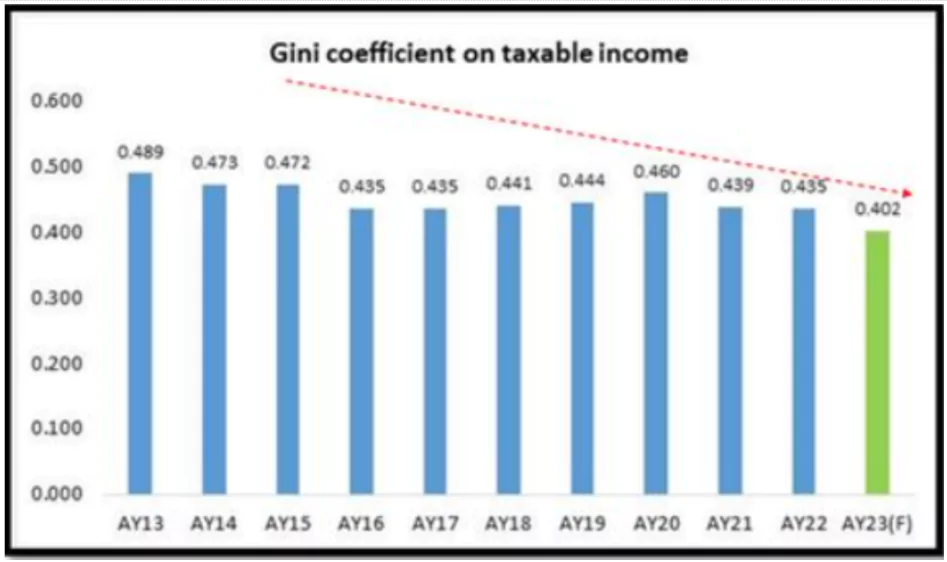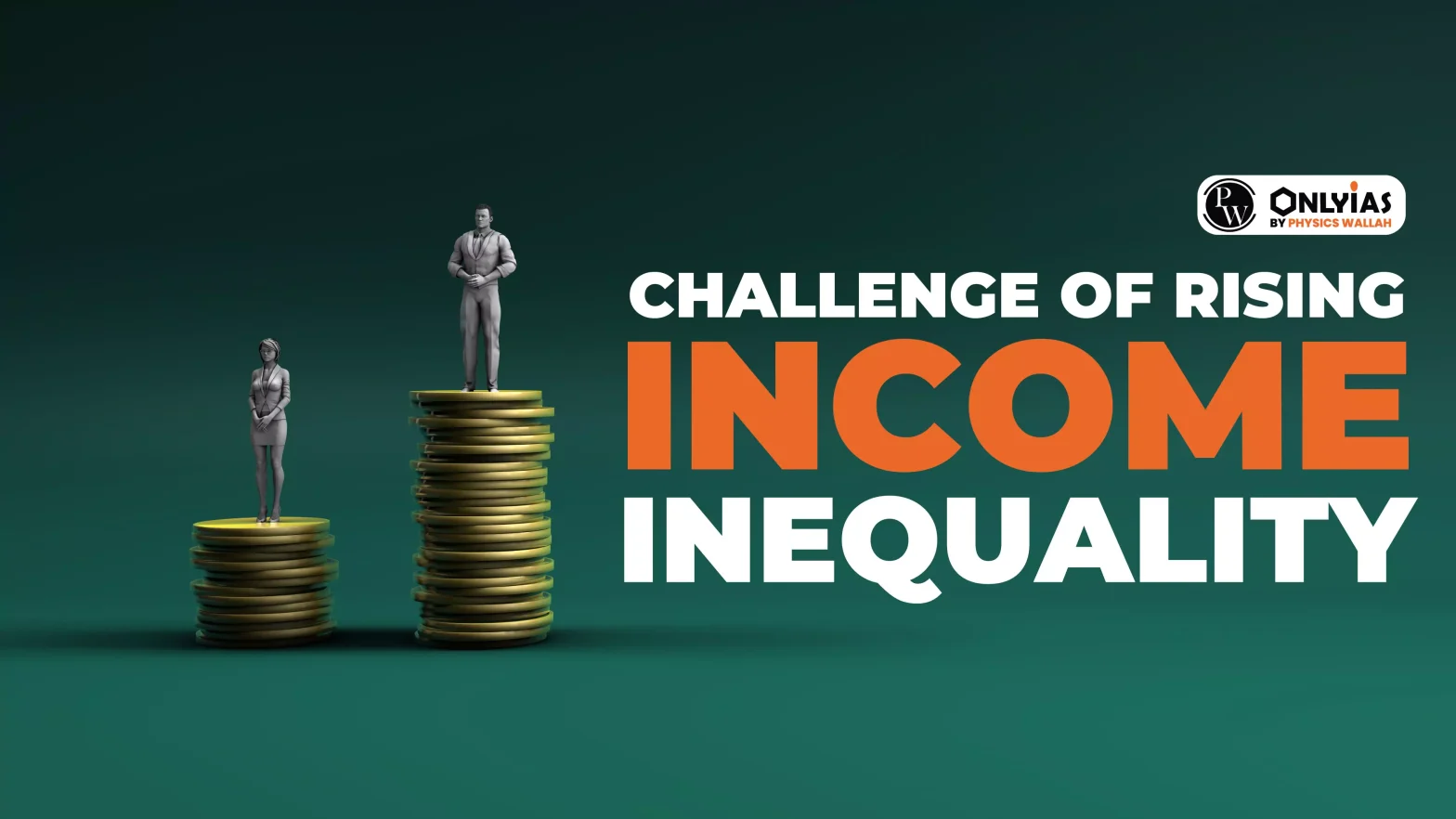Recently, the ILO’s World Employment and Social Outlook study (September 2024) links the global decline in worker’s income share to technological changes, especially automation and artificial intelligence (AI).
Crucial Insights on the ILO Study
According to the International Labour Organisation’s (ILO), tech innovations have boosted labour productivity, output, but can also reduce labour income share.
- Over the past two decades (2004-24), global labour income share has dropped by 1.6%.
- Nearly, 40% of this decline was in the pandemic years of 2019-22.
- The study highlights that, In 2024, 28.2% of young women worldwide are not in employment, education or training, double that of young men (13.1%).
- This gender disparity presents significant challenges for developing nations with large working age population, such as India, where 83% of its unemployed are youth.
Enroll now for UPSC Online Course
State Of Income Inequality In India
- World Inequality Lab’s (WIL’s) Finding: According to the World Inequality Lab’s (WIL’s) recent working study, ‘Income and Wealth Inequality in India, 1922-2023: The Rise of the Billionaire Raj’:
- 22.6% of India’s national income in 2022-23 went to the top 1%, the highest proportion in the last 100 years.
- For wealth inequality, the share of the top 1% in wealth was as high as 40.1% in 2022-23, also its highest level since 1961.
- The share of wealth among the top 10% increased from 45% in 1961 to 65% in 2022-23.
- Conversely, the share of the bottom 50% and middle 40% in wealth has declined: The rich got richer and the poor got poorer.
- Oxfam India’s Report: According to Oxfam India’s report (“Survival of the Richest: The India story”):
- Wealth Concentration: The combined wealth of India’s 100 richest has touched $660 billion (Rs 54.12 lakh crore).
- Economic Inequality: It finds that 5 percent of Indians own more than 60 percent of the country’s wealth. In comparison, the bottom 50 percent of the population possess only 3 percent of the wealth.
- World Inequality Lab Finding: In India, the share of the top 1% in the national income is among the highest in the world, and that India is today more unequal as a society than it was under British rule.
- SBI Research Report: According to the SBI Research Report, income inequality has declined in recent years, supporting the trend of upward migration through increased income and the ascent of the Indian middle class.
- Income Tax base is widening by the year and the number of persons filing Income Tax Return increased to 74 million in Assessment Year 2022-23 from 70 million in AY 2021-22.
- For the Assessment Year 2023-24, a total of 82 million Income Tax Returns have been filed till 31 December 2023.
- SBI Research has calculated that Gini Coefficient has declined from 0.472 during Assessment Year 2014-15 to 0.402 for AY 2022-23.
- The share of Top 2.5% tax payers with income more than Rs 10 crores has declined from 2.81% in 2013-14 to 2.28% in 2020-21.
- The share of Top 1% tax payers with income more than Rs 100 crores has fallen from 1.64% to 0.77% during the similar period.

About Income Inequality
Income inequality refers to the unequal distribution of income among individuals or groups within a society.
Gini Coefficient
- Gini Coefficient is one of the most widely used measures of income inequality.
- The Gini Coefficient score lies between 0 and 1, where complete equality would result in a Gini Coefficient of zero and complete inequality would result in 1.
|
- It indicates the extent to which income is distributed unevenly in a population. Income inequality can manifest between different socioeconomic groups, regions, genders, or even ethnic groups.
- Measuring Income Inequality:
- Gini Coefficient: A common measure of income inequality that ranges from 0 (perfect equality) to 1 (maximum inequality).
- Lorenz Curve: Graphically represents income distribution, showing the proportion of total income earned by cumulative percentages of the population.
Check Out UPSC CSE Books From PW Store
Major Reasons Leading To Income Inequality In India
- Education and Skills: Individuals with higher education or specialized skills tend to earn more than those with less education or fewer skills.
- The All India Survey of Higher Education (AISHE) showed in 2021-22, the overall gross enrolment ratio (GER) in higher education for the age group 18-23 years was 28.4%, but this varied significantly by socioeconomic status.
- Disparity in Access to Engineering Education: 70% seats are in higher-income states.
- Technological Change: While technology can create new job opportunities and increase productivity, it also leads to job displacement and widens the skills gap.
- High-skilled workers often benefit from technological advancements, commanding higher wages and enjoying job security, while low-skilled workers face job losses or wage stagnation.
- Globalization: Globalization, by way of integrating economies, culture, technology, and governance, significantly affects income inequality.
- Global economic integration may favor skilled workers and capital owners, increasing inequality.
- Government Policies: Taxation and social welfare policies can either reduce or exacerbate income inequality.
- India’s Union government barely captures under 8% of the workforce in income tax; it does not have an inheritance tax and has abolished its wealth tax.
- Historical Factors: The British and industrialists developed only those regions that possessed rich potential for prosperous manufacturing and trading activities. For example, Kolkata, Mumbai and Chennai.
- Labor Market Structures: Decline of labor unions, minimum wage laws, and bargaining power affect wage distribution.
- Labour Force Disparity: In northern and central states, the labour force participation rate and the percentage of workers with regular wage are below the national average.
- Unemployment in India stood at 8.1% in February 2022, as per Centre for Monitoring Indian Economy (CMIE) data.
Measures To Address The Issue Of Income Inequality In India
- Progressive Taxation: Implement tax policies that redistribute wealth from affluent individuals to marginalized communities.
- Use tax revenues for public services such as health, education, skill development, and environmental sustainability.
- Focus on facilitating job creation and economic opportunities for lower-income groups.
- Education and Skill Development: Ensure access to quality education for all, focusing on equal opportunities for marginalized communities.
- Increase earning potential through continuous upskilling and vocational training.
- Fair Labor Laws: Enforce labor rights, including safe working conditions and minimum wage regulations.
- Eliminate child labor and ensure protection against worker exploitation.
- Strengthen collective bargaining rights to ensure workers benefit from economic growth.
- Investment in Infrastructure: Reduce regional disparities by investing in sustainable infrastructure development.
- Ensure inclusion and sustainability in transportation and other critical public infrastructure.
- Contribution of the Super Rich: Encourage billionaires and the wealthy to donate their wealth for public welfare.
- For example, support initiatives like the ‘Giving Pledge’ launched by Bill Gates and Warren Buffet.
- Introducing Special Inheritance Tax: It applies only to the super rich and large asset transfers. This tax has been proposed by several people in the past in India. However, in India, there is currently no tax on inheritance.
- In many advanced countries there is a special inheritance tax (Japan 55%, South Korea 50%, France 45%, and the United States 40%) before transferring wealth to the next generation.
- Following Gandhian Model of Development: The Gandhian model of development with a focus on decentralisation, local needs, local talent, local resources, local production make sense in a hyper-connected world.
- India has 800 districts with unique climate, natural resources, capabilities and talent to build 800 production centres for a variety of goods and services.
- It also means 800 digital platforms to network to build supply chain, logistics, markets and distribution centres.
Enroll now for UPSC Online Classes
Conclusion
There is a need for locating the resources needed to lift millions more out of poverty and joblessness, and to do this in ways that encourage value addition through production and efficiency, quality and consumption as well as inclusion, sustainability, dignity and justice.
![]() 6 Sep 2024
6 Sep 2024


